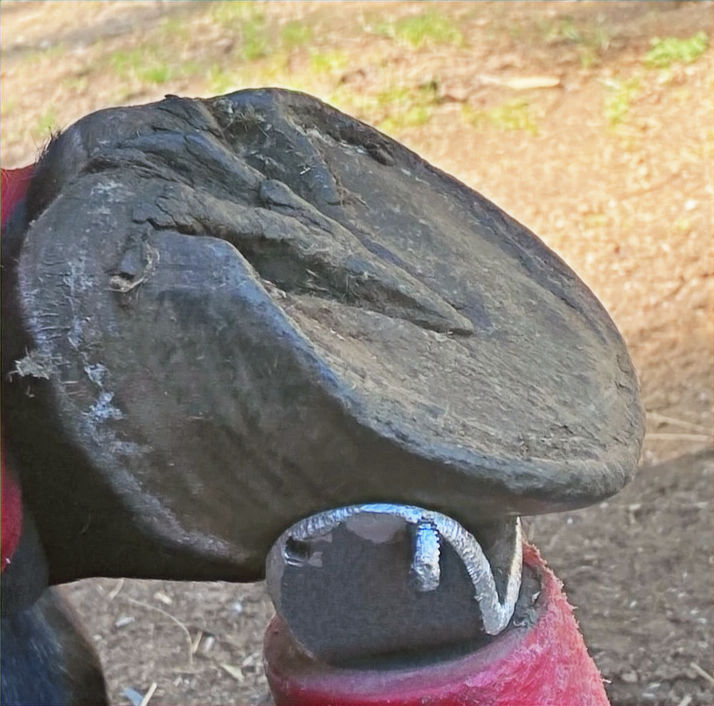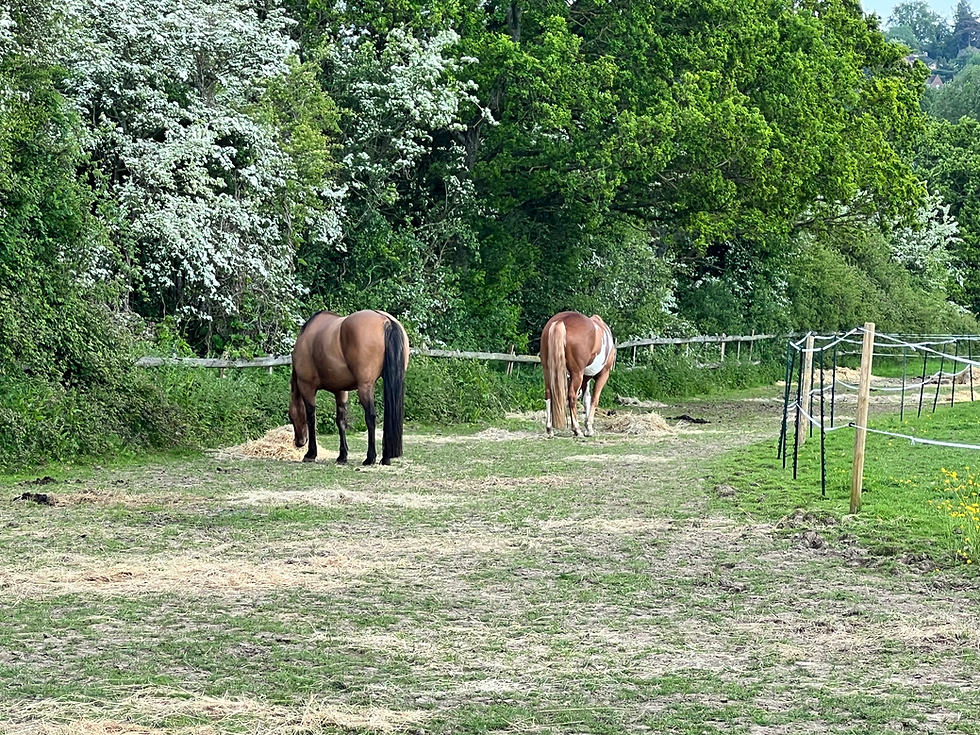Why a short (weekly!) trim cycle is the gold standard of hoof care?
- Riikka Kemppainen
- Sep 10
- 7 min read

For generations, horse owners have followed a 6–8 week hoof trim schedule. This approach is still widely seen as “standard,” even by many professionals. But if we think about how a horse’s hooves are designed to function - constantly wearing down through movement - we start to realise this long trim cycle may be working against the horse’s natural needs.
In the wild, hooves self-trim. But our domestic horses don’t travel tens of kilometres each day across varied terrain. So when we only trim every couple of months, hoof growth builds up - and problems begin.
Let’s take a closer look at what actually happens between trims, why a weekly hoof trim is the gold standard, and what horse owners can do to help their horse stay sound and healthy all year round.
A hoof shouldn’t look like it needs trimming
By the time a hoof looks like it needs a trim, damage has already been occurring, often for weeks. Most of that damage is internal: small separations, lamellar stress, distortion of the hoof capsule. Unless you know exactly what to look for, it's easy to assume "he'll be fine after a trim." But fine isn’t the same as functioning optimally.
If your horse needs a significant hoof trim every 6–8 weeks (where a lot of material is removed during a trim), it's a sign the hoof has already grown beyond its functional shape.
How fast do hooves actually grow?
The average hoof wall grows 10mm (3/8 inch) per month
That’s around 15mm (over ½ inch) of growth after 6 weeks
And about 20mm (¾ inch) after 8 weeks
For an animal that walks on its toenails, that’s a lot of extra material... and it changes how the hoof functions, long before the next hoof trim comes around.
After 4+ weeks, hooves start to behave like they’re shod
Even if your horse is barefoot, a long trim cycle creates the same mechanical issues as shoes:
The hoof becomes peripherally loaded (weight-bearing on the wall only), stressing the laminae and reducing sole thickness.
Excess toe length strains tendons and disrupts the alignment of the bony column.
Forward or high heels lift the frog off the ground, reducing shock absorption and natural hoof expansion on landing.
Overgrown bars are an abscess hazard
Flared hoof walls exert pulling pressure on the pedal bone, resulting in bone damage.
None of these outcomes support a healthy, functioning hoof.
The problem with “catch-up” trimming
When the trim cycle is too long, we’re constantly playing catch-up. Often, there’s too much hoof to safely remove in one go. Taking it all off at once risks soreness, which understandably upsets owners. The result? Many trimmers leave hooves “partly trimmed”, which means the horse continues living with the effects of overgrown feet.
This cycle of hoof distortion, temporary improvement, then overgrowth again keeps the horse in a constant state of imbalance. Circulation dips and recovers, but never stabilises.
And here’s the trap: when a horse isn’t visibly lame, owners assume the feet are fine - even though long-term damage may still be occurring.
Long trim cycles = long-term hoof issues
When you’re constantly correcting problems rather than maintaining balance, the horse never gets a break. Add in the low-grade inflammation that most horses experience from traditional feeding and turnout practices, and the result is chronic, unresolved hoof stress.
And let’s not forget: in spring, hoof growth can double, meaning damage builds even faster.

What does a short trim cycle actually fix?
My trim clients are all on a four-week hoof trim schedule (except for a break over Christmas). Even then, for some horses (and at certain times of the year), four weeks is still too long.
People sometimes suggest trimming every 4 weeks in summer and stretching to 6 in winter. But in truth, the hoof trim cycle should go the other way: every 2 weeks in spring, and 4 weeks in winter. That’s what hooves need. Is it practical for most trimmers or owners? Not really. But that doesn’t make the biological reality any less true.

Weekly trims: not crazy - just correct
When I first started offering four-week trims, it felt like a hard sell. No one else was doing it. But now, people seek me out specifically because of the shorter hoof trim cycle. They’ve seen the results: consistently good hooves, sound horses, and fewer vet visits.
And no, diet can’t be left out of the conversation. Even the best hoof trim won’t overcome poor nutrition or an inappropriate living environment. The hoof needs internal building blocks and external movement to truly thrive.

Changing how we think about hoof trims
We’ve all grown up hearing that trimming every 6–8 weeks is “normal.” But it’s just a habit, not a biological truth.
Four-week trims became my way of balancing horse health with owner expectations. But now that the conversation around weekly hoof trims is gaining momentum, it’s time to re-think again.
Let’s break it down logically:
If we trim 1–3mm off the hoof every week, we’re mimicking the wear wild horses experience naturally
If we wait 6–8 weeks, we’re allowing excessive growth to affect posture, joint alignment, and hoof function
There is no upside to waiting longer.
The conveyor belt analogy
Dr. Robert Bowker likens hoof growth to a conveyor belt: the wall, sole, and heels all grow forward and downward. If we don’t stay ahead of that growth, the hoof runs away from us.
And once it does, we’re no longer maintaining - we’re fixing. Again and again.
Ask yourself: what positive things happen in the hoof between weeks 4 and 6 of a trim cycle?
None.

So, why not just trim weekly?
A weekly hoof trim is better than every four weeks, no question. It’s like running a high-performance sports car on premium fuel instead of cheap stuff. Yes, it’s more effort, but it protects the system and prevents damage before it starts.
Prevention is always easier (and cheaper!) than repair.
But who has time to trim every week?
It’s not always practical for professionals to offer weekly trims across the board. I do trim some of my client horses weekly, but those horses are often very ill or in rehab, and don’t stay on that schedule forever.
The long-term solution is this:
Horse owners can learn to maintain their own horse’s hooves
That might mean doing small rasping sessions between professional trims, or eventually taking over completely. There’s a lot of fear-mongering out there, but trimming is not rocket science. No one cares more about your horse’s hooves than you do.
With the right education and ongoing support, learning how to perform a weekly maintenance hoof trim is entirely achievable. In fact, the owners who rasp weekly between visits often have horses in better shape than I can keep with monthly trims alone.
Even if your early trims aren’t perfect, they’re still better than letting 6–8 weeks of growth pile-up.
Real-life results: weekly vs. no maintenance
Let’s look at some examples. In the photos below:
Both horses went 7 weeks between professional trims
One had weekly maintenance rasping done by the owner
The other had no trimming at all during that time
These are the hooves at the end of the 7-week trim cycle, before the professional trim.


The difference? Huge. Not perfect, but clearly healthier and more balanced in the horse receiving regular owner care.
Other photos show horses and ponies with different trim cycles: from 7 weeks, to 4, to as short as 1–3 weeks. The hoof form, posture, and comfort levels reflect the trim frequency every time.




The takeaway: keep ahead of the growth
Hoof growth moves forward. That’s not a theory, it’s a biological fact.
Trying to “fix” long growth every 6–8 weeks doesn’t work. At best, it’s damage control. At worst, it causes avoidable pain and sets the horse up for long-term problems.
A consistent, short hoof trim cycle - ideally weekly - is the gold standard of hoof care.


8yo Thoroughbred gelding, never shod. 3 years in a grass free home on a one to three week trim cycle.

Want to get started with trimming your own horse?
If you’re curious about trimming between professional visits, or even learning to trim fully yourself, we can teach you. We offer courses, support, and practical guidance for horse owners of all experience levels.
Because the truth is this: a better hoof trim cycle starts with you.









